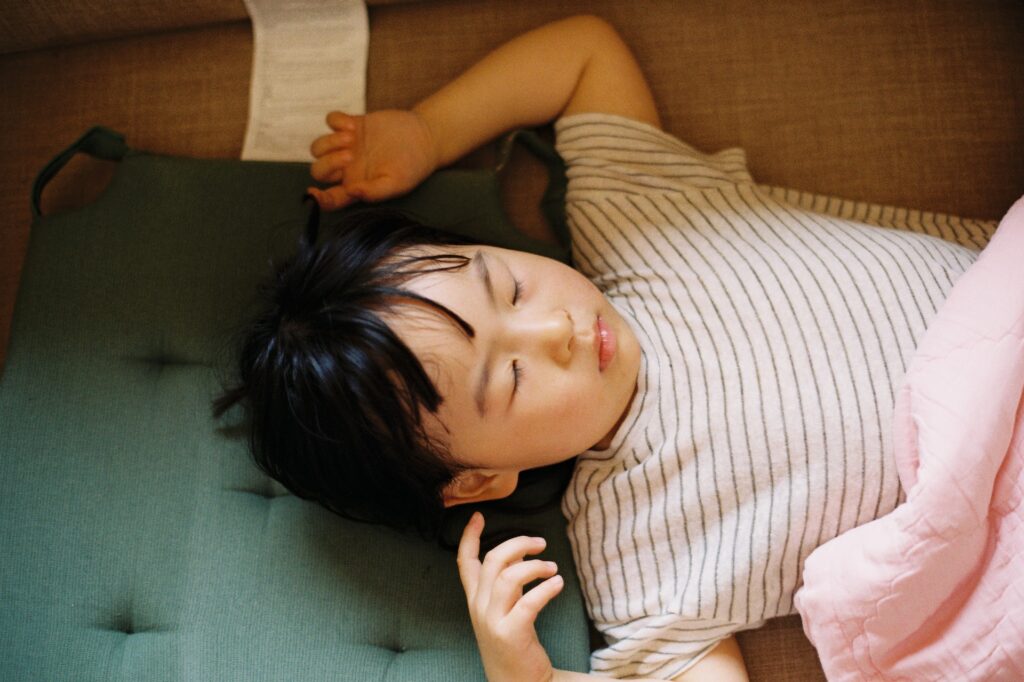Many parents and caregivers wonder about the need for kindergartners to take naps during the school day. After all, kindergartens focus more on academic activities as they prepare children to transition to elementary school and beyond. While naptime is essential for younger kids, napping becomes more of a question as children age. Kindergartners still take naps, but their needs change over time. Let’s look at the benefits naps provide and the signs that your child is ready to change their napping habits.
Can Naptime Offer Academic Benefits?

Image by zhenzhong liu is licensed with Unsplash License
Naptime contributed to a normal part of early childhood classroom activities for a long time, but today, kindergarten classes typically trade that time for more educational opportunities. You may look back fondly on the naps you had at school when you attended kindergarten. However, today’s classrooms have shifted their focus to meeting high academic standards. Schools replace naptime with learning time and engaging cognitive activities, which provides teachers with extra classroom time to help their students reach higher achievement levels.
At the same time, naps significantly benefit a child’s academic growth and development in preschool and kindergarten. According to research funded by the National Science Foundation, students performed better on recollection learning tasks when they napped. So, how does napping help children academically? Naps let memory consolidation, a process where the brain transforms short-term memories into long-term ones, take place. Memory consolidation assists brain development and makes memory transfer more efficient. In other words, allowing a child to nap enhances learning by improving their minds.
The conversation around sleep is slowly changing in education overall. Many high schools, for instance, delay school start times to fit with teenagers’ circadian rhythms. Federal policies do not exist regarding scheduled time for naps, but schools can start considering their youngest students when organizing their school days. After all, good sleep habits build the cognitive foundation for excellent educational performance.
Do All Kindergartners Need To Take Naps?
Like so many things, the need for naps varies for each individual. The American Academy of Sleep Medicine says that kids ages 3 to 5 require at least 10 to 13 hours of sleep every 24 hours. Naps help achieve this requirement. And though not all young children need this rest, almost all kids would benefit from having that pause in the day to process the information they’re learning.
Students from vulnerable backgrounds stand to benefit the most from nap breaks. If a child isn’t getting enough replenishing sleep during the night at home, they come to school the next morning needing rest. Having naptime built into the day allows children who arrive tired to catch up to their peers in a calm, quiet, and safe space.
Is Your Child Ready To Stop Napping?
It is important to consider your child’s specific, individual needs when assessing their napping habits. The age when children stop napping can vary, and kids should generally stop when they don’t need naps to feel energized for full days. Additionally, many kids naturally stop sleeping in the daytime when they’re ready.
Here are some signs that may show your child no longer requires a nap:
No Signs of Sleepiness
If your child isn’t yawning, having trouble staying awake during the day, or feeling cranky in the evening, they most likely do not depend on napping anymore.
Difficulty Falling Asleep When It’s Time To Nap
Kids who aren’t tired and can maintain a consistent mood during the day without napping may find it difficult to fall asleep at naptime. Maybe your child is lying in bed awake or only napping for a few minutes. These are examples that your child no longer needs naps. However, if your child is fussy, they may still need some rest but with an adjusted timing.
Not Napping at All
Is your little one not sleeping at all during scheduled naptime? Are they choosing to sing or play in bed? Are they continuing to read or play in their room? Doing so with no signs of sleepiness can mean your child doesn’t need their naps.
Difficulty Falling Asleep at Night
If your child struggles to doze at bedtime, naps may be the culprit. Napping during the day can delay your child’s ability to fall asleep at night, resulting in less sleep overall. You can reduce the length of your child’s nap or remove it altogether, but avoid making bedtime later to maintain a healthy sleep schedule.
Waking up Early
Unnecessary naps can mean your child feels fully rested before their wake-up time in the morning. Again, if your child still needs to nap but wakes up early, you can try shortening naptime.
When Do Children Still Need Naps?
Infants up to a year old typically nap one to four times a day. Children require fewer and fewer naps as their brains mature, depending on only one nap per day by 18 to 24 months. The need generally decreases as kids grow, but many older kiddos — including kindergartners — still benefit from naps. And like there are signs your child doesn’t need to nap, certain signs will tell you your child is not ready to give up naptime.
A sign could be your child’s behavior shifting negatively in the evenings, which might come across as irritability because a lack of sleep negatively impacts emotions. Likewise, if you find your child struggling to stay awake during the day after a full night’s rest, they probably still need their daily nap. Shortening the length of their naps prepares your child to transition out of napping.
As napping shows, kindergartners have unique needs. A kindergarten program that meets your child’s individual needs while building their educational foundation can set your child up for growth and development in kindergarten and beyond. Learn more about Crème de la Crème’s private kindergarten program near you and schedule a tour today. Our high-quality kindergarten program is ready to help your child develop into a curious lifelong learner.
